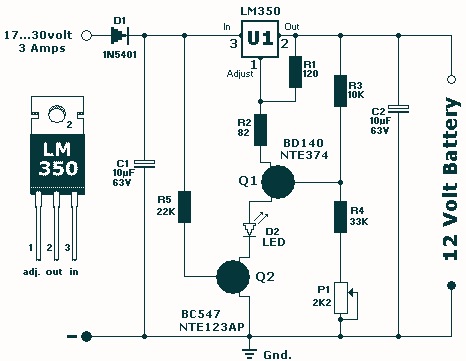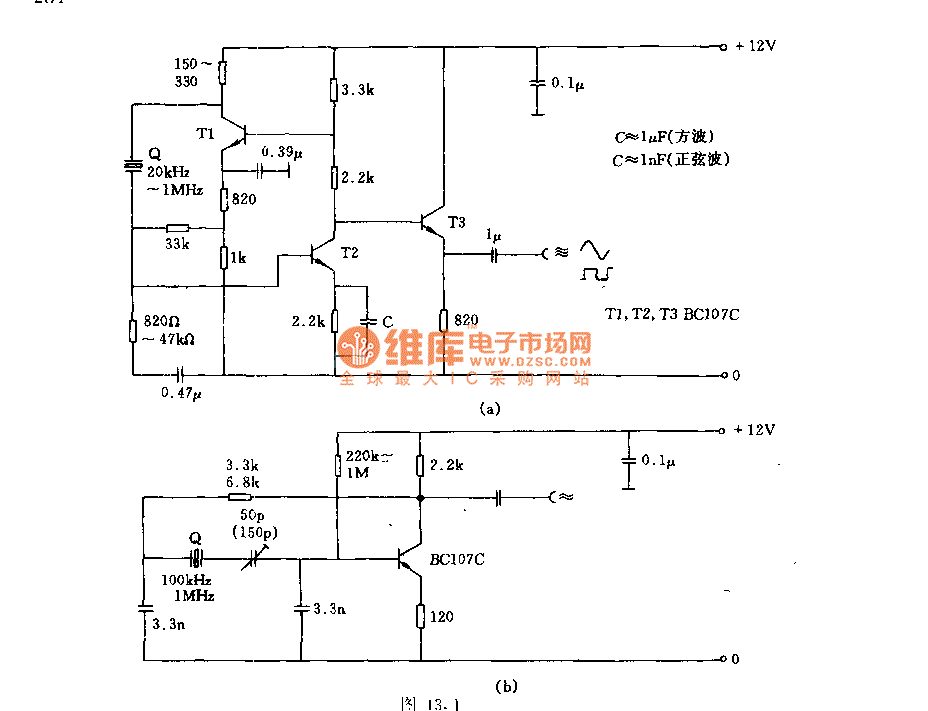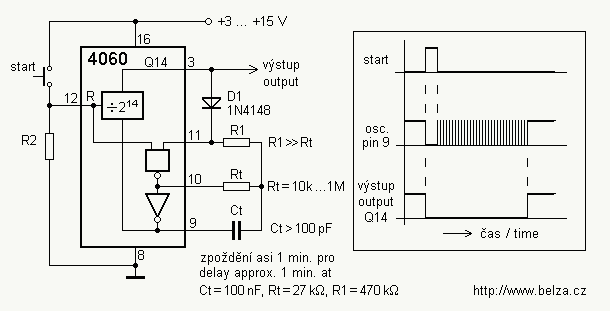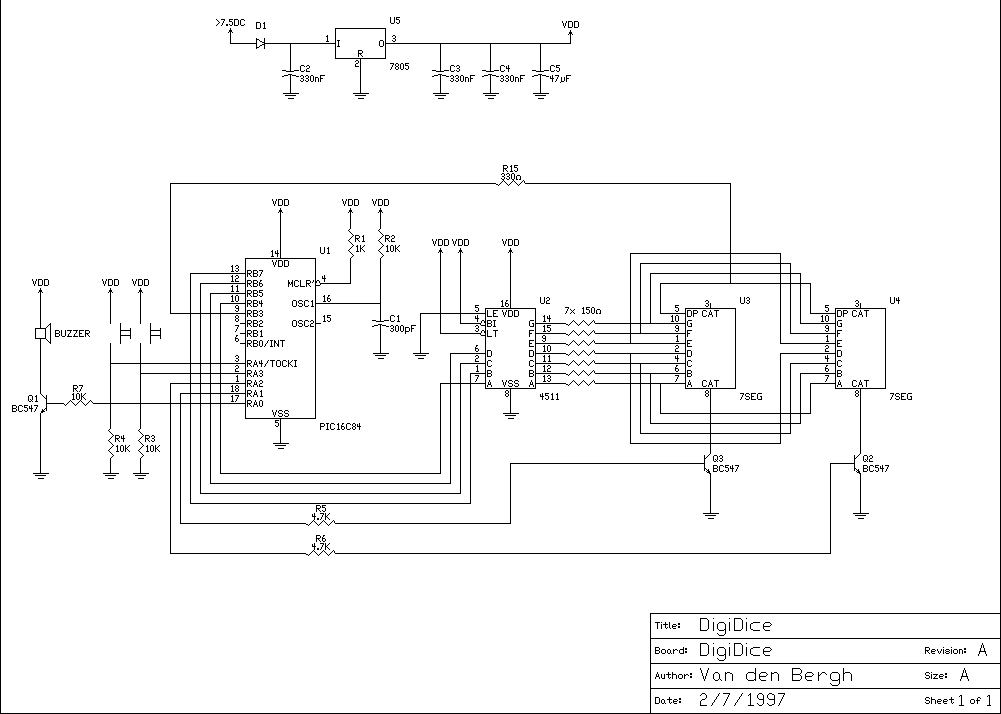
LED dot display based Battery charge level indicator circuit diagram
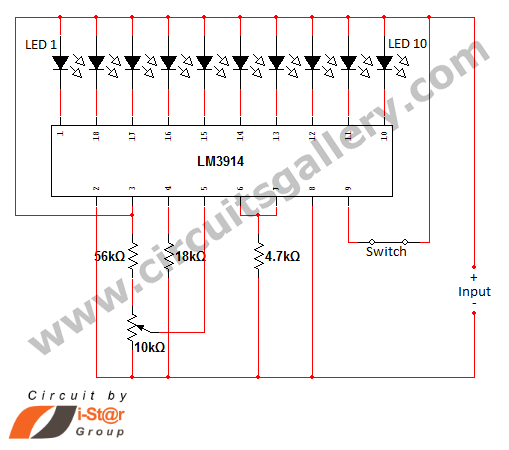
In various situations, it is necessary to indicate the amount of battery charge using methods such as LED dot displays or LED bar displays. This circuit utilizes the LM3914 integrated circuit to serve as a battery charge indicator with an LED dot display. The LM3914 can detect voltage levels and drive a display of 10 LEDs in either dot mode or bar mode. Previously, a temperature level sensor using the same IC (LM3914) was discussed. This circuit can also function as a low battery voltage indicator by calibrating it appropriately. It is particularly suited for indicating the status of a 12-volt battery, as it is calibrated for this voltage. However, it can be modified to monitor and display other voltage levels as well. The LM3914 is essentially a millivolt measuring IC that converts varying millivolt inputs into corresponding LED indications, resembling a linear analog display. The IC operates within a supply voltage range of 3V to 25V DC. Brightness control of the LED can be achieved by adjusting an external resistor. The output pins of the LM3914 are compatible with both TTL and CMOS logic levels. A switch is connected to pin 9 to select between dot mode and bar graph mode. When the switch is closed, pin 9 connects to the positive supply, enabling bar graph mode. To configure this, the resistor R3 should be removed, and a high voltage (less than 25V) should be applied to the input, adjusting the potentiometer until the 10th LED lights up in dot mode. After this, a low voltage can be connected to the input following the removal of the high voltage. A high-value potentiometer should be connected to pin 4, and it should be adjusted until only LED1 is illuminated.
The battery charge indicator circuit based on the LM3914 integrated circuit is designed to provide a visual representation of battery voltage levels through LED displays. The circuit leverages the LM3914's ability to operate in two modes, dot mode and bar mode, allowing for flexibility in display preferences. In dot mode, each LED lights up sequentially based on the input voltage, while in bar mode, all LEDs light up simultaneously to represent the voltage level more prominently.
The calibration for a 12V battery involves configuring the circuit to ensure accurate voltage readings. The LM3914 can handle input voltages up to 25V, making it suitable for various applications beyond just 12V batteries. The external resistor connected to the IC allows for brightness adjustments, which can be useful in different lighting conditions or to save power.
The selection of operational modes is facilitated by a simple switch connected to pin 9. This feature enhances user interaction with the circuit, allowing for quick toggling between display modes depending on the user's preference or requirement. The removal of resistor R3 and the careful adjustment of the potentiometer are crucial steps in setting up the circuit for optimal performance.
In practical applications, this circuit can be implemented in various battery-powered devices where monitoring battery status is essential. It is particularly valuable in portable electronics, electric vehicles, and renewable energy systems, providing users with immediate feedback on battery health and charge levels. The design can be further customized for different voltage ranges by modifying the reference voltage and component values, ensuring versatility across multiple use cases.At many situations we need to display the amount of battery charge through some kind of indication methods like LED dot display or LED bar display. Here CG comes with a battery charge indicator circuit using LED dot display. This battery power level indicator circuit is build around LM3914 IC. It is able to sense voltage levels and is capable to d rive a display of 10 LEDs in dot mode or bar mode. We have already posted a temperature level sensor using this same IC (LM3914). This can also be used as a low battery voltage indicator circuit as it displays low voltage if you calibrate it to do so. Our circuit is most suitable for 12 volt battery status indication because we are calibrating it for 12V battery.
You can alter this DIY battery level indicator circuit for monitoring and displaying other voltages also. It is basically a milli volt measuring IC which is able to convert a varying milli volt input into a corresponding LED indication like a linear analog display.
The IC LM3914 can operate with a wide range of supply voltage (3V to 25V DC). We can control the brightness of LED by programming via an external resistor. The outputs pins of LM3914 are compatible for both TTL and CMOS. To select dot mode or bar graph mode a switch is given at the 9th pin. When switch is closed, pin 9 of the IC gets connected to the positive supply, then bar graph mode is enabled. For this just eliminate the resistor R3 and connect the high voltage (less than 25V) to the input and adjust the potentiometer until the 10th LED glows (in dot mode).
Now connect a low voltage at the input after removing high voltage. Then connect a high value potentiometer at the 4th pin, adjust it until LED1 glows alone. 🔗 External reference
The battery charge indicator circuit based on the LM3914 integrated circuit is designed to provide a visual representation of battery voltage levels through LED displays. The circuit leverages the LM3914's ability to operate in two modes, dot mode and bar mode, allowing for flexibility in display preferences. In dot mode, each LED lights up sequentially based on the input voltage, while in bar mode, all LEDs light up simultaneously to represent the voltage level more prominently.
The calibration for a 12V battery involves configuring the circuit to ensure accurate voltage readings. The LM3914 can handle input voltages up to 25V, making it suitable for various applications beyond just 12V batteries. The external resistor connected to the IC allows for brightness adjustments, which can be useful in different lighting conditions or to save power.
The selection of operational modes is facilitated by a simple switch connected to pin 9. This feature enhances user interaction with the circuit, allowing for quick toggling between display modes depending on the user's preference or requirement. The removal of resistor R3 and the careful adjustment of the potentiometer are crucial steps in setting up the circuit for optimal performance.
In practical applications, this circuit can be implemented in various battery-powered devices where monitoring battery status is essential. It is particularly valuable in portable electronics, electric vehicles, and renewable energy systems, providing users with immediate feedback on battery health and charge levels. The design can be further customized for different voltage ranges by modifying the reference voltage and component values, ensuring versatility across multiple use cases.At many situations we need to display the amount of battery charge through some kind of indication methods like LED dot display or LED bar display. Here CG comes with a battery charge indicator circuit using LED dot display. This battery power level indicator circuit is build around LM3914 IC. It is able to sense voltage levels and is capable to d rive a display of 10 LEDs in dot mode or bar mode. We have already posted a temperature level sensor using this same IC (LM3914). This can also be used as a low battery voltage indicator circuit as it displays low voltage if you calibrate it to do so. Our circuit is most suitable for 12 volt battery status indication because we are calibrating it for 12V battery.
You can alter this DIY battery level indicator circuit for monitoring and displaying other voltages also. It is basically a milli volt measuring IC which is able to convert a varying milli volt input into a corresponding LED indication like a linear analog display.
The IC LM3914 can operate with a wide range of supply voltage (3V to 25V DC). We can control the brightness of LED by programming via an external resistor. The outputs pins of LM3914 are compatible for both TTL and CMOS. To select dot mode or bar graph mode a switch is given at the 9th pin. When switch is closed, pin 9 of the IC gets connected to the positive supply, then bar graph mode is enabled. For this just eliminate the resistor R3 and connect the high voltage (less than 25V) to the input and adjust the potentiometer until the 10th LED glows (in dot mode).
Now connect a low voltage at the input after removing high voltage. Then connect a high value potentiometer at the 4th pin, adjust it until LED1 glows alone. 🔗 External reference

